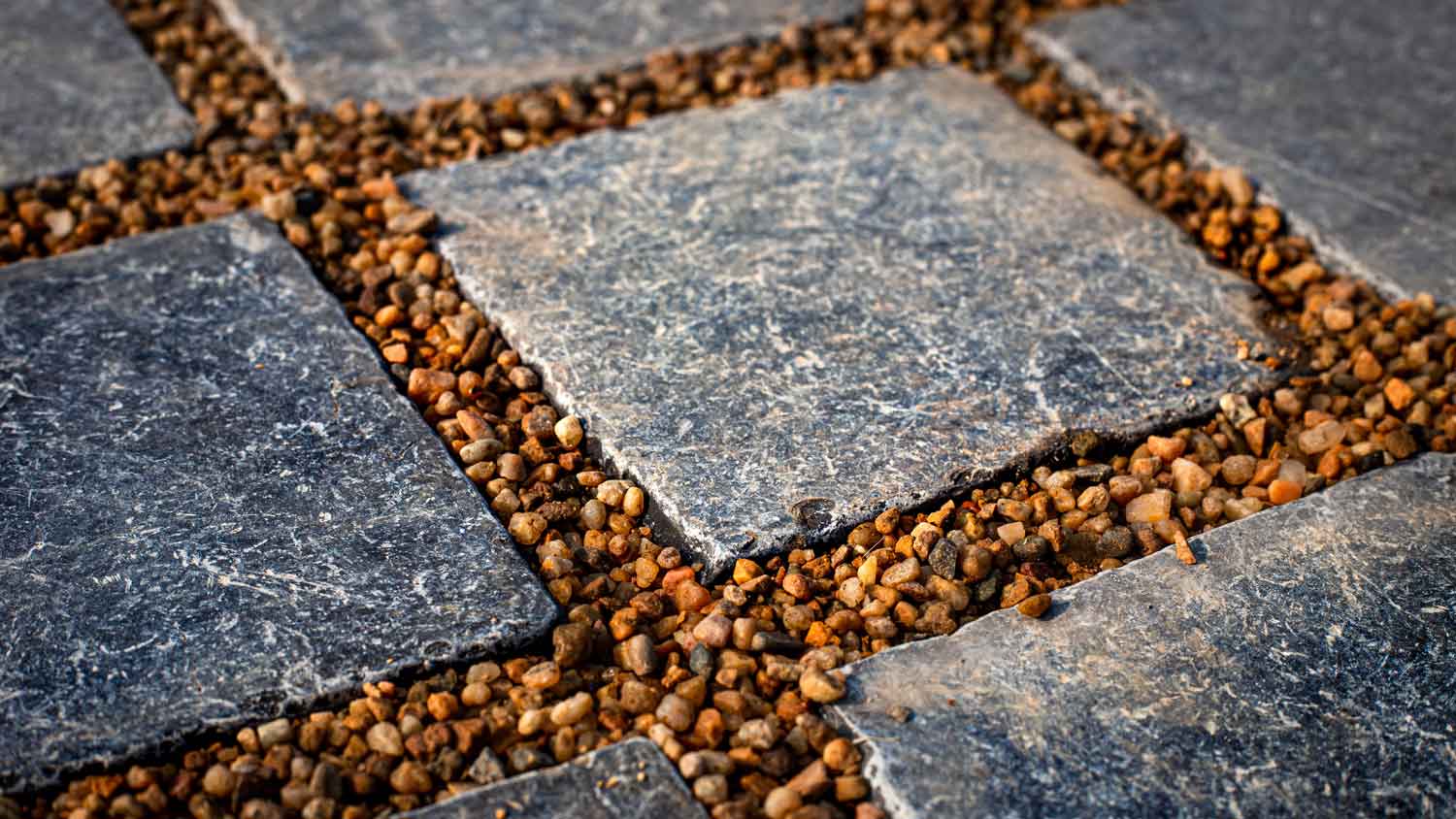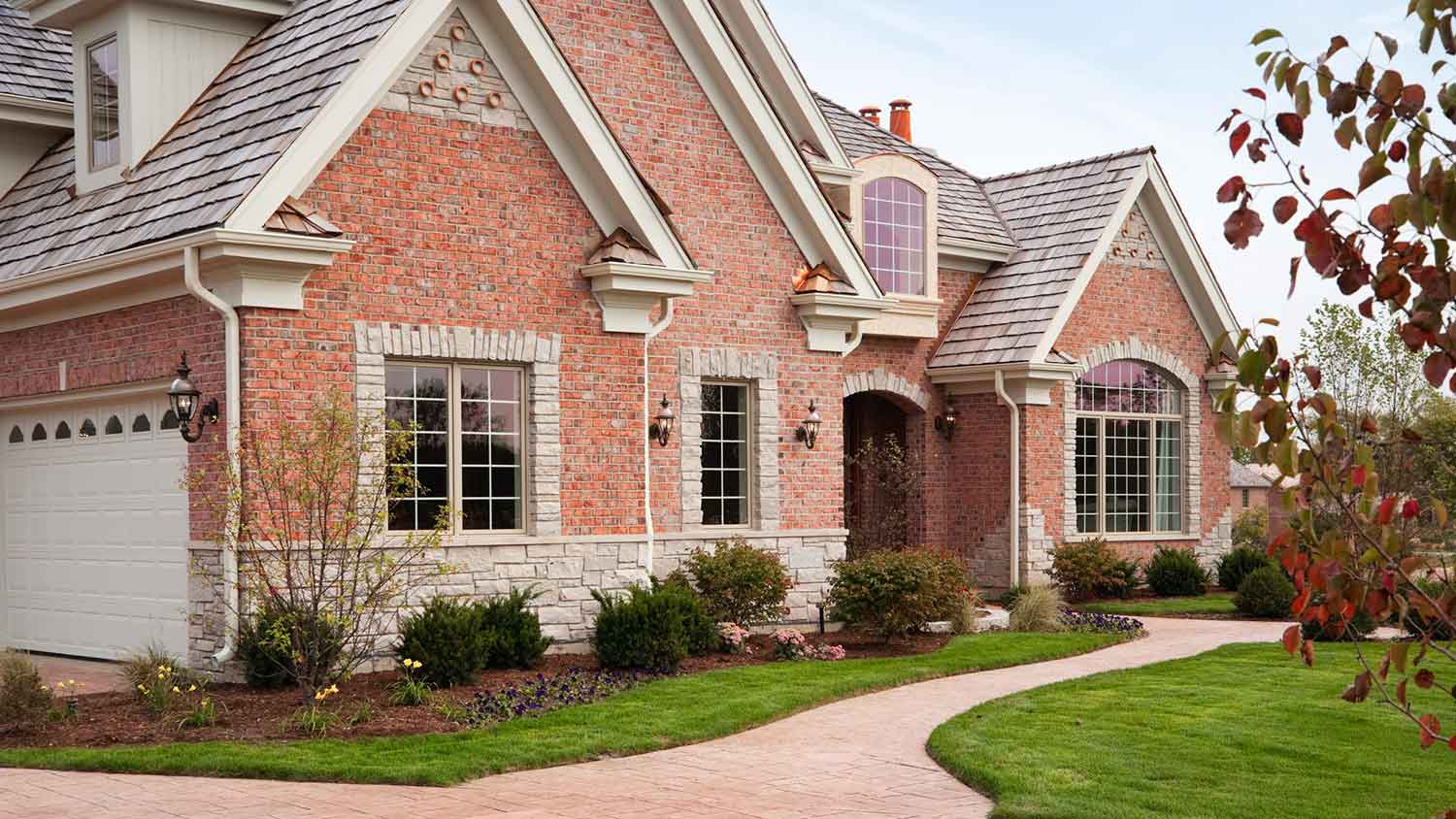
The cost to replace brick front steps depends on the type of brick, square footage, pattern, and more. Learn how much you may spend on this project.
Discover the natural appeal of bluestone


Bluestone is a naturally occurring construction material that's almost exclusively mined in Pennsylvania and Virginia's Shenandoah Valley.
Bluestone is one of the most versatile construction stones. It is used for walkways, pool patios, stairs, fireplaces, and more.
The naturalness and mining difficulties of bluestone put it in a higher price tier than synthetic options.
While durable and easy to care for, bluestone does require resealing and consistent maintenance to avoid water damage, staining, and erosion.
The naturalness of bluestone can make it difficult to get a uniform look.
Intrigued by Bluestone? This prized sediment may be the secret to creating gorgeous landscaping or one-of-a-kind architectural features at your home. What is bluestone exactly? Let's lay down the blueprint for why bluestone is the construction material of choice when beauty and durability are top priorities.
If you're looking up bluestone inspiration online, it's important to know that you may be looking at two different materials. That's because bluestone can either be Shenandoah bluestone or Pennsylvania bluestone. Whether you're looking for patio pavers or types of stone for fireplaces, it's important to know the difference before you start loading your cart with construction materials.
Pennsylvania bluestone is technically a type of sandstone. As you may have guessed by the name, it's mined in Pennsylvania. The grains of this stone can vary in color with tones of blue, grey, brown, and rust. Pennsylvania bluestone is commonly used for:
Walls
Steps
Sidewalks and walkways
Garden paths
Patios
Fireplaces
Flooring
Countertops
Architectural features
Shenandoah bluestone is a variety of limestone that's made from calcium carbonate. Almost all Shenandoah bluestone sold is mined from Virginia's beautiful Shenandoah Valley. While this type of bluestone starts off with a signature grey-blue color, it tends to turn grey with age. Shenandoah bluestone is often used for:
Patios
Walkways
Garden paths
Poolside patios
Stone steps
Entryways and thresholds
The cost of bluestone and other stones can vary significantly depending on factors such as the quality, size, thickness, source, and location. You’ll need to connect with a local supplier to nail down exact costs, but these average prices give you a general idea of how much you’ll spend.
| Type | Average Cost |
|---|---|
| Bluestone | $7 per square foot |
| Bristol valley | $10 per square foot |
| Richcliff | $12 per square foot |
| Treo premier | $8 per square foot |
Bluestone comes in a variety of finishes. The standard cuts for bluestone are rectangular and square. In general, contractors and landscapers will lay out bluestone pieces of different sizes in a staggered pattern. Some of the options you might come across when shopping for bluestone include:
Sandblasted/slightly textured
Rock-facing/distressed
Natural cleft/split
Flamed finished/dimpled
Polished/smooth
Tumbled/soft-edged
True blue/blemish-free
Sawn/saw-marked
Sawn and honed
Snapped edge
Bluestone is prized for its beauty and versatility. Its durability and high-end aesthetic make it a popular choice for outdoor landscaping and pool features in the Northeast. However, it's important to weigh the full picture of bluestone's pros and cons before committing to this construction material.
Extremely difficult to crack.
Lasts for years with basic care and maintenance.
As a naturally occurring material, bluestone endures harsh weather with grace.
The rough surface of bluestone prevents it from becoming slick or slippery when wet. This is why it's such a popular choice for pool patios and outdoor stairs.
Bluestone comes in a variety of shapes and sizes. When creating custom aesthetics on their properties, homeowners can also choose from precision-cut tiles or rough-looking stone.
The timeless look of bluestone allows it to fit in with both modern and traditional architectural styles.
Bluestone can be more expensive than other options, averaging between $7 and $15 per square foot. Naturally occurring construction materials are generally more expensive than synthetic materials because they exist in finite quantities. Extracting bluestone is also more difficult than creating synthetic stone.
Bluestone is a naturally occurring construction material that comes in irregular shapes, making it difficult to install unless you purchase refined stones.
Dark bluestone can absorb heat in the summer months to make poolside walking surfaces hot.
Bluestone's natural color and texture variations can make it difficult to create a uniform appearance.
Bluestone requires regular maintenance, including periodic resealing, to protect it from staining and moisture infiltration. Without regular cleaning, debris, and dirt can also cause surface erosion.

There are some best practices to know about when using bluestone that can help to ensure a successful project. As mentioned earlier, bluestone's naturalness is simultaneously what makes it such a durable, beautiful option and creates some of its biggest challenges. Here's what you need to know:
Start by deciding if your project requires uniform pavers or irregular stones. While irregular stone poses more installation difficulties, it is often the better choice when integrating bluestone into a garden or natural-looking landscaping project.
It's important to measure stone depth when purchasing bluestone. Bluestone is generally sold in thicknesses of 1 inch to 1 1/2 inches. Thinner bluestone can generally cover more area for the same price as thicker bluestone.
When using bluestone landscaping pavers, the area must be prepared and leveled before the stone can be laid. Bluestone should be installed over gravel, sand, or cement.
Bluestone pavers should be edged to avoid movement after installation.
Trying to install bluestone without prior experience with stonework or knowledge of how to cut stone is difficult. While laying pavers down for rough garden paths is doable as a DIY project, doing any kind of construction work or patio building with bluestone is best left to professionals. Local masonry experts near you should be able to source bluestone for you, design a plan with you, and handle installation and sealing. Of course, one of the most important questions to ask a masonry contractor is if they specifically have experience with bluestone.
From average costs to expert advice, get all the answers you need to get your job done.

The cost to replace brick front steps depends on the type of brick, square footage, pattern, and more. Learn how much you may spend on this project.

Need to repoint brick in your home to make your home look fresh and new? Use this guide to repointing brick cost to price out your project before starting.

Discover the average stone restoration cost, including price ranges and key factors, to help you plan your next home project with confidence.

If you own a historic brick home, you’ll want to pay attention to cracks, moisture, and settling—and greenlight a historic masonry restoration if they arise.

Maintaining a brick home requires inspections, cleaning, and sealing. Learn essential brick house maintenance tips to prevent rot, mold, mildew, and structural issues.

Sealing brick typically isn’t necessary, but that’s not always the case. Explore the pros and cons of sealing brick walls to see if this project is right for you.